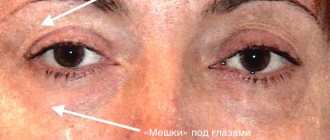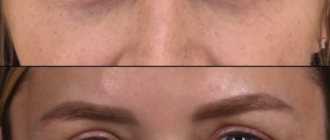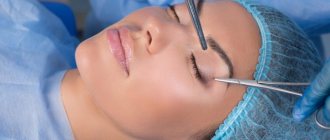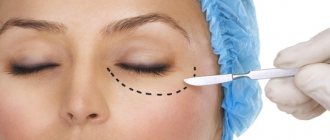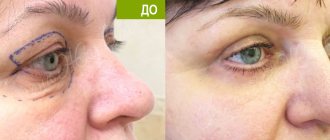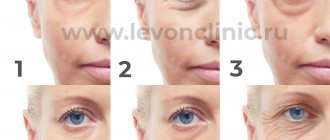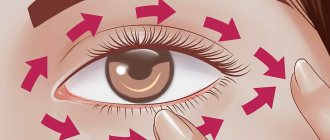Eyelid surgery is a plastic surgery that can significantly rejuvenate the area around the eyes, change the shape and shape of the eyes, remove bags under the eyes and sagging upper eyelids. Ptosis, or sagging tissue, can make you look sullen and tense, which is not conducive to positive communication. Do you want to restore youth and natural beauty to your face? In this case, sign up for a consultation at our clinic!
The advantages of our plastic surgery center are:
♦ Application of unique, progressive techniques ♦ Fame and positive reputation among patients ♦ Solid experience, Dr. Fadin’s experience in plastic surgery is more than 20 years ♦ Performing operations using methods that are safe for health ♦ Personal approach to each patient
Types of plastic surgery on the eyelids
Depending on what problem bothers the patient, we can perform the following operations:
♦ Circular eyelid lift or correction of the lower and upper eyelids ♦ Upper blepharoplasty - elimination of sagging upper eyelid ♦ Lower blepharoplasty - elimination of dark circles and bags under the eyes ♦ Elimination of bags and swelling under the eyes - transconjunctival blepharoplasty ♦ Correction of Asian eye shape or otherwise - Europeanization ♦ Canthopexy or canthoplasty - lifting the drooping corners of the eyes
Indications for canthoplasty
Indications for canthoplasty are divided into aesthetic and medical. The first ones include the following:
- age-related weakening of tendons and muscle fibers with subsequent drooping of the corners of the eyes;
- moderate ptosis of the lower eyelids, their sagging;
- "crow's feet";
- eye asymmetry;
- “bags” under the eyes;
- desire to simulate an “almond-shaped” eye shape.
Medical reasons for surgery include eye deformities resulting from various congenital or acquired diseases:
- the effect of bulging eyes as a result of advanced myopia;
- increased eye pressure;
- congenital fusion of eyelids (partial);
- inversion/inversion of the eyelid;
- too short palpebral fissure as a result of injury.
Types of canthoplasty
Types of lateral canthoplasty
Scheme of medial canthoplaty
How to prepare for surgery
Before eyelid surgery, you must undergo an examination to make sure that you have no contraindications.
Choose the date of the operation so that you have a couple of weeks of free time after it. These two weeks of the immediate postoperative period should be spent at rest to allow your body to heal its wounds and regain new youth.
At home, you need to prepare eye ointment with an antibiotic, ice, and sterile gauze pads.
If you smoke, stop smoking completely two weeks before surgery. There are no special restrictions regarding alcohol before surgery.
How does canthoplasty work?
Before the operation begins, the surgeon marks the areas requiring correction using a special marker. At the next stage, the eyelids are treated with an antiseptic. Then anesthesia is administered and the surgeon begins to cut the skin. The surgeon makes an incision in the dermis of the upper/lower eyelid from the side of the conjunctival sac/along the growth of the eyelashes (depending on the chosen technique). As a rule, the length of the incisions does not exceed 1 cm. Through the incision, the surgeon tightens/loosens the tendons responsible for the size of the palpebral fissure. Similar work is done with muscles. If necessary, excess fat and skin are removed. At the final stage, the surgeon sutures the wound and a bandage is applied to the eyelid.
How the procedure is performed
Before the operation, an experienced anesthesiologist will come to your room, and after a conversation with him, your anxiety will leave you. Then everything is in a fog, usually in a pleasant fog.
Incisions are made in the natural folds of the lower and upper eyelids. This allows you to make the seam almost invisible. We distribute fat from the bags under the eyes, eliminate sagging, tighten tissues and fix them in a new position.
The final stage is the application of neat cosmetic stitches. After some time, the scars fade and become invisible.
How is eyelid lift surgery performed?
There are several types of blepharoplasty, each of them differs in technique and results. The doctor will choose the method of intervention after a personal examination.
Upper eyelid blepharoplasty
Upper eyelid blepharoplasty is performed at any age. The operation helps to get rid of fatty hernias above the eyes or severe ptosis. The intervention is performed under general or local anesthesia, the procedure lasts about an hour. Before surgery, the doctor makes markings: determines the places where there is excess skin.
Next, following the markings, a skin incision is made, fatty hernias are isolated and removed, which are removed along with excess skin. Then the doctor applies a cosmetic suture, which is removed after 7-10 days. As a result, a thin scar remains, which completely heals in 1-2 months and becomes almost invisible.
Lower eyelid blepharoplasty
Blepharoplasty of the lower eyelids helps not only with facial wrinkles. This operation also effectively copes with sagging musculocutaneous tissue, fatty hernias, skin folds, and bags under the eyes.
The average duration of lower eyelid blepharoplasty is 40-60 minutes. The essence of the intervention is to correct the lower eyelid area: the doctor cuts the skin 2 mm from the eyelash growth line. Then he identifies fatty hernias and excises them along with excess skin. Afterwards, cosmetic stitches and a blindfold are applied.
The consequences of lower eyelid blepharoplasty can only be assessed after 1-2 months: you need to wait until the swelling has completely subsided and the stitches have dissolved. This rejuvenation technique is considered highly effective; the results last for 7-10 years.
Circular eyelid surgery
Circular blepharoplasty is the most effective plastic surgery that can cope with sagging, fatty hernias and facial wrinkles. Thanks to this procedure, it is possible to tighten the skin of both the upper and lower eyelids, remove age-related changes or congenital defects.
Circular blepharoplasty is a complex surgical procedure, which is why it requires special training and experience from the surgeon. The duration of the operation is 1.5-3 hours: it all depends on the chosen technique. The essence of circular blepharoplasty is to combine lifting of the upper and lower eyelids.
Correction of the corners of the eyes
Correction of the corners of the eyes is canthopexy. Usually performed in conjunction with lower blepharoplasty. The operation is performed to restore the face to a youthful and fresh appearance. The intervention is carried out under local (superficial sleep) or general anesthesia. The doctor makes an incision in the natural crease of the outer surface of the eyelid, through which he reaches the canthal tendon. This is what holds the corners of the lower eyelid. The tendon is stretched and fixed at the periosteum of the orbit. Then it is fixed with a cosmetic suture.
If there is too much skin in the lower eyelid area, fragments of it are removed. In this case, the muscles are not excised: they are stretched and fixed together with the tendon at the periosteum. The operation ends with excision of excess skin and suturing. As a result, there will be 2 nodules on the surface: at the beginning and end of the cut. After 5 days, the stitches are removed, they heal quickly, turn pale and become invisible.
Postoperative period
The period of complete recovery after blepharoplasty is 10-12 days. After this time, you will be able to go outside, communicate with people, and apply makeup.
The rate of tissue recovery depends on the following criteria:
♦ Condition of the patient’s skin ♦ Features of the structure of the tissues around the eyes ♦ Age of the patient ♦ Compliance with doctor’s instructions
After the operation, slight swelling of the soft tissues appears, and sometimes bruises. You can wash your face with plain tap water, take a shower, and then wipe your face with a dry, clean towel. Antibiotic eye ointment should be applied to the eyelids twice a day.
The sutures are removed 4-5 days after surgery.
The timing of returning to work after eyelid surgery depends on your attitude towards your appearance and the nature of your work. If you want no one to notice anything, it is better to have 2-3 weeks in reserve.
The issue of visiting the pool requires special attention. The fact is that if during the operation we performed plastic surgery of the tear trough to form a smooth transition from the eyelid to the cheek, then for three months pressure on this area is unacceptable. Therefore, you should not use pool goggles after surgery, which put pressure on the lower part of the eye socket. There are very comfortable glasses that look like a small mask, so please put them on.
| EVENT | HOW LONG AFTER THE OPERATION CAN THIS BE DONE? |
| To wash hair | 1 day |
| To drive a car | 1 day |
| Going to work | 1-3 weeks |
| Removing stitches | 4-5 days |
| Sex life | 1 Week |
| Sunbathe in the sun or in a solarium | 1-2 weeks until bruises disappear |
| Fitness with a gentle load | 3 weeks |
| Pool | 3 weeks |
| Mandatory follow-up visit to the doctor | 2 months |
A visit to a cosmetologist after eyelid surgery is welcome, but here there are certain restrictions. Before you begin the procedure, inform your cosmetologist that you have had eyelid surgery.
| EVENT | HOW LONG AFTER THE OPERATION CAN THIS BE DONE? |
| Lymphatic drainage facial massage | 1 Week |
| Microcurrents | 1 Week |
| Gentle cosmetic care, without mechanical cleaning | 10 days |
| Botox or Dysport injections | 3 weeks |
| Peeling | 1 month |
| Face massage | 1 month |
| Laser resurfacing | 1 month |
| Injections of hyaluronic acid preparations | 6 months |
Are you wondering how much eyelid blepharoplasty costs in Moscow? The price for this service depends on the specifics of the planned operation. Blepharoplasty is performed in many clinics and medical centers, and accordingly, the cost of eyelid blepharoplasty in Moscow varies. At our plastic surgery clinic, the cost of blepharoplasty ranges from 90,000 rubles to 180,000 rubles.
Rehabilitation period after canthoplasty
The patient can leave the hospital within a few hours after the operation. The duration of the rehabilitation period is 2 – 3 weeks. During this time, a number of requirements must be met:
- sleep exclusively on your back, with your head in a slightly elevated position;
- Avoid exposure to direct sunlight in the eye area;
- do not allow sharp downward bends;
- limit reading books, watching TV, working on the computer;
- refuse contact lenses;
- Avoid getting water in your eyes.
As a rule, sutures are removed on the 4th – 7th day. Gradually, the scars turn white and become completely invisible after a month and a half.
Prices
| PLASTIC SURGERY | PRICE, |
| Upper eyelid surgery | 110 000 |
| Lower eyelid surgery | 150 000 |
| Plastic surgery of the upper and lower eyelids | 250 000 |
| Transconjunctival blepharoplasty | 150 000 |
| Asian eyelid surgery or sangapuri | 120 000 |
| Lipofilling of the upper eyelids | 70 000 |
| Lipofilling of the lower eyelids | 70 000 |
| Lipofilling of the upper and lower eyelids | 100 000 |
| Removing paint bags | 190 000 |
Types of blepharoplasty
Blepharoplasty is a whole complex of surgical operations performed on the eyelids. Each type of intervention is aimed at eliminating a specific defect. The following types of blepharoplasty are distinguished:
- Upper. The most common type of operation. Involves removal of skin and excess fat in the upper eyelid area. As a result, the skin stretches and the look becomes fresh.
- Bottom. The surgery removes excess skin and fat from the lower eyelids.
- Circular. This type of surgery is aimed at lifting both the upper and lower eyelids at the same time. As a result, you can achieve an excellent anti-aging effect.
- Transconjunctival. This is a gentle type of operation in which all manipulations are performed through an incision on the conjunctival surface of the eyelid. As a result, the rehabilitation period is reduced to 1 week, and pain is practically absent.
- Canthoplasty. A special technique aimed at not changing the shape and shape of the eyes;
- Europeanization, or plastic surgery of Asian eyelids. A type of blepharoplasty in which the surgeon shapes the fold of the upper eyelid and, if necessary, removes the epicanthus. As a result, the distance between the eyes visually decreases, the gaze becomes open.
- Canthopexy. An operation designed to lift the corners of the eyes. As a result, the face looks fresher and more youthful.
Contraindications to canthoplasty
Like any other type of surgery, canthoplasty has some limitations. Thus, the operation is not performed if the patient has one or more of the following factors:
- blood diseases;
- diabetes;
- severe diseases of the heart, kidneys and blood vessels;
- ophthalmological diseases (myopia, dry eye syndrome, increased intraocular pressure, conjunctivitis, glaucoma, cataracts);
- inflammatory processes;
- tumor neoplasms, including retinoblastoma.
